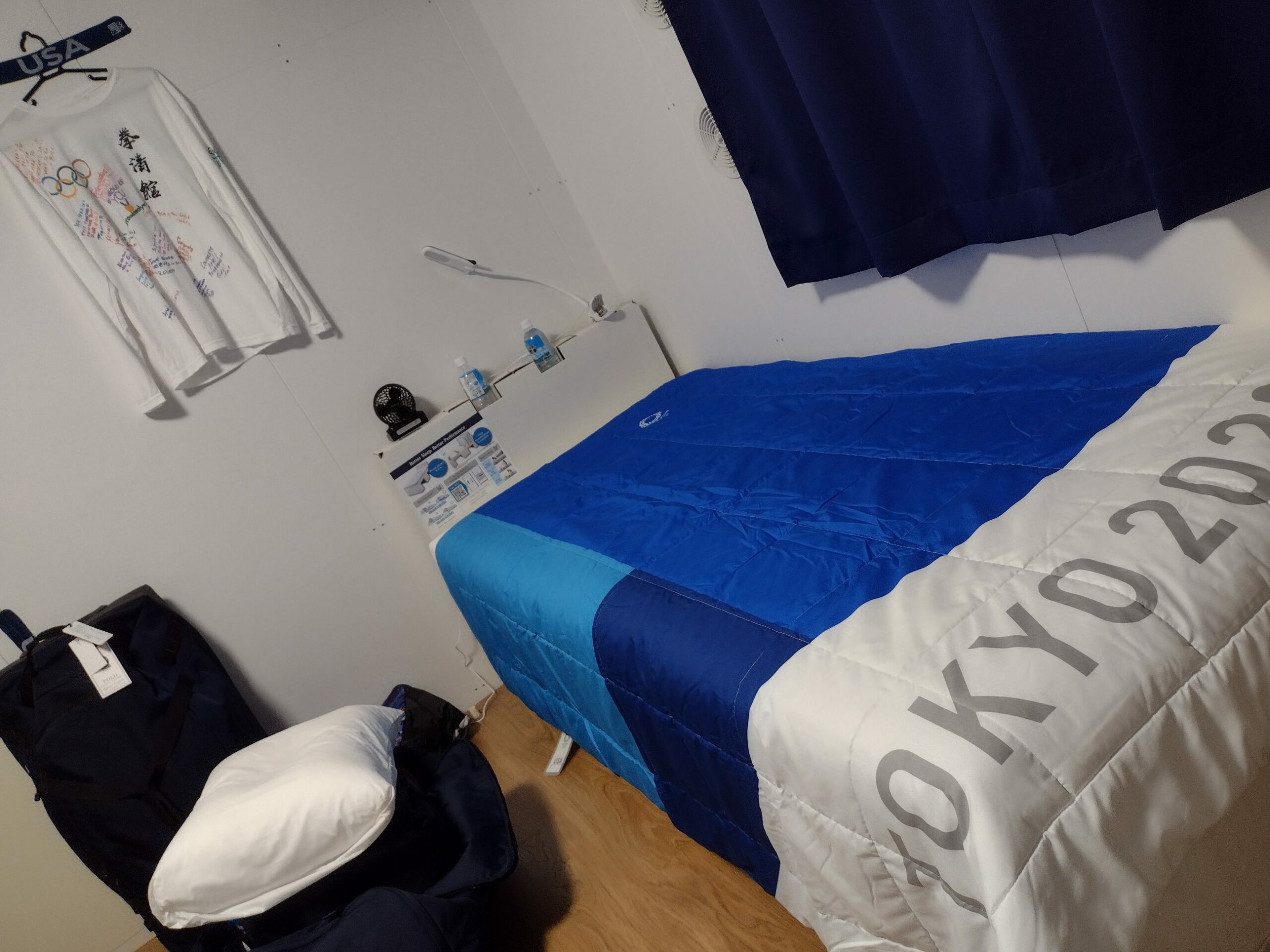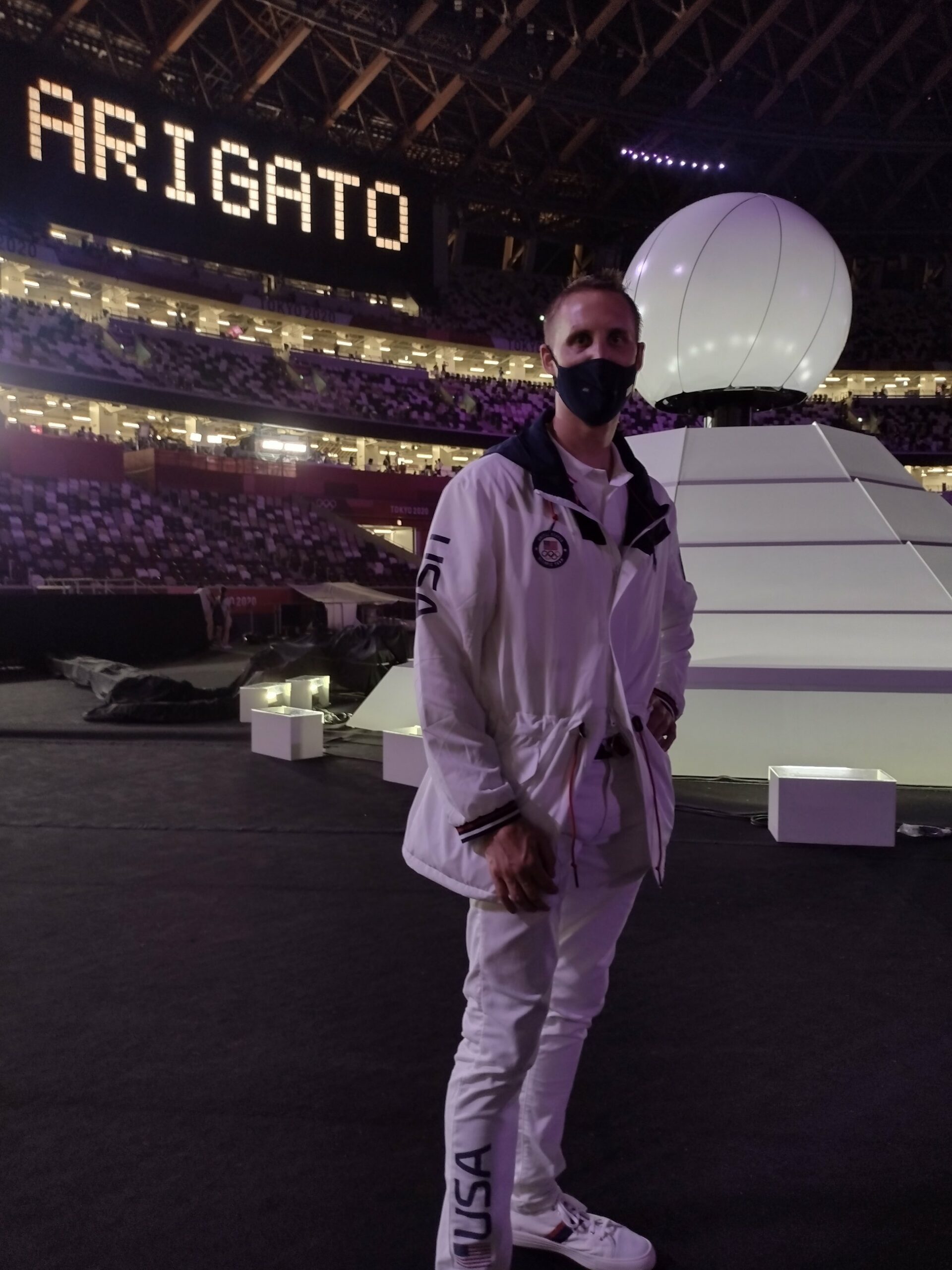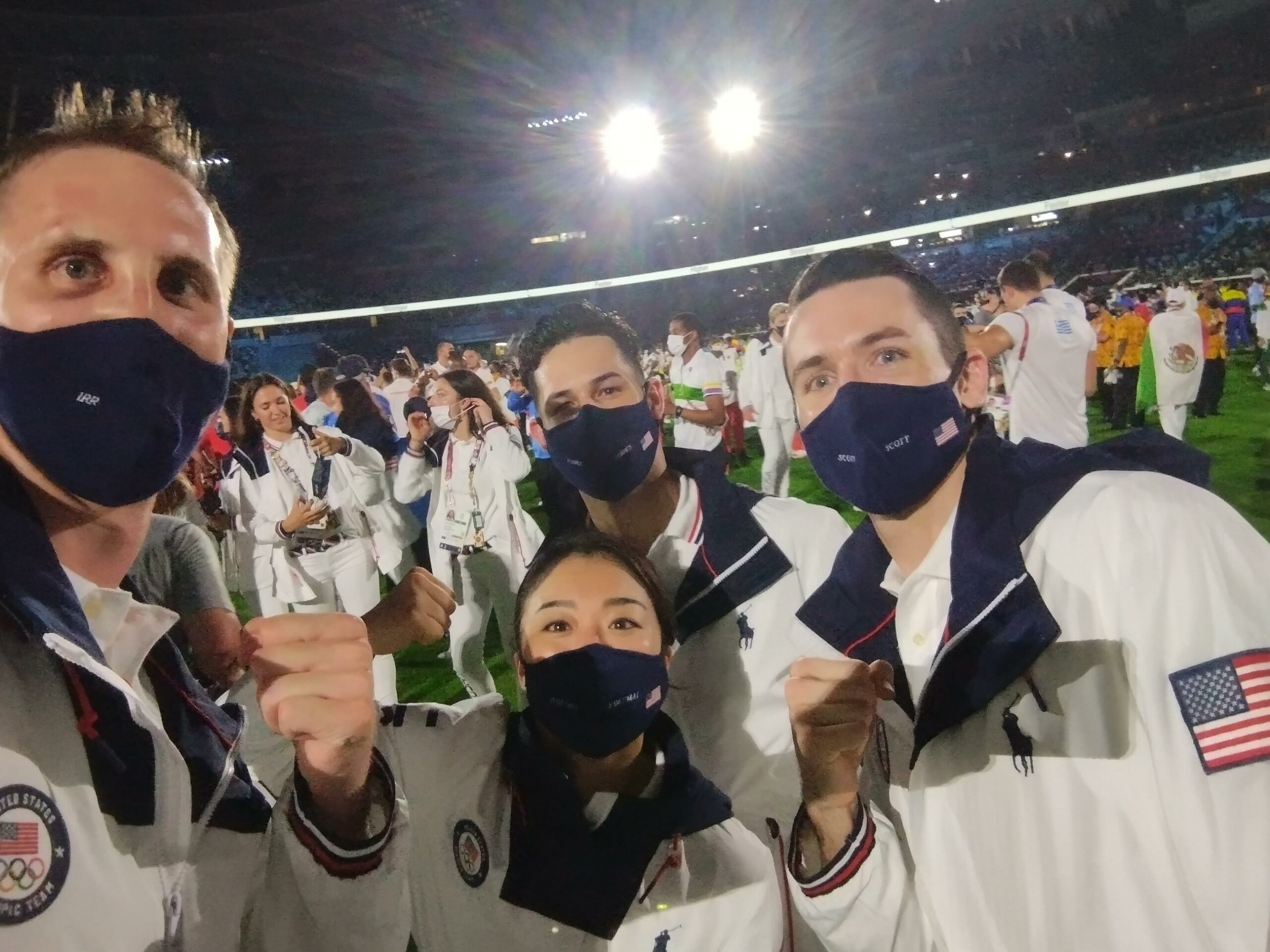Like so many of us at home, Brian Irr was uncertain of what to expect at the 2020 Summer Olympics held this past July and August in Tokyo. Unlike all of us, Irr, a karateka, was competing. The 18-year Team USA veteran has competed in his fair share of international tournaments, including winning bronze and gold medals in the +84 kilogram division of men’s kumite, a form of sparring, at the 2015 and 2019 Pan American Games. And so any trepidation the Plano-trained athlete felt was overcome by the sheer joy of living his childhood dream of not only seeing his sport make its Olympic debut but competing in the historic event.
Irr began practicing karate when he was 8, signing up for classes with his younger brother near his childhood home in upstate New York. Eventually his younger brother decided to pursue other sports, but Irr stuck with karate. “I have always enjoyed it,” Irr says. “I enjoy the competitiveness of it and the process of improving myself and striving to reach a certain level of perfection in my technique, skills and athletic ability.”
The addition of karate to the Olympic sporting program was first considered in the 1970s, but its inclusion was not approved until late 2016. When this decision was announced, Irr knew that he wanted to compete in Tokyo.
He began training with Brody Burns at the Academy of Classical Karate in Plano in November 2017. “I wanted to make the most of the opportunities I had leading into the Games,” Irr said. “I was living back in Buffalo, New York and the training situation there wasn’t ideal, based on training partners available and other things. So I made the decision to move here to Dallas to put myself in the best position possible to qualify for and compete in Tokyo.”
Although Irr’s ninth place finish in Tokyo was lower than he had hoped for or expected, he is still grateful for the opportunity represent Team USA and proud of how he tackled all of the unknowns leading into and at the Games. I sat down with Irr, who now calls North Texas home, to learn what competing at an Olympic Games during a pandemic was like. This interview was condensed and edited for clarity.

Obviously leading up to Tokyo there was a lot of uncertainty and I know for a lot of other sports important qualification events were postponed or canceled all together. What was your qualification process like?
Irr: I qualified via an individual qualification spot, meaning that I qualified a spot for myself and not just a quota spot for Team USA. There are a couple of ways to qualify, one being through world ranking, another through a continental selection event and a third way through a last chance qualifying event. The world ranking selection process started back in 2018 with our Premier League tournament series, which is 14 international tournaments a year for two years.
So every month, at least once a month, we were traveling to a different event earning Olympic ranking points to qualify for Tokyo.
Can you talk me through some of the pros and cons of dealing with the one year delay of the Games?
Irr: At the very beginning of the pandemic, when we found out that the next couple of events were postponed, before they were canceled and rescheduled for the following year, the initial reaction was actually relief because at that time we had been traveling so much for two years straight that it was getting pretty burdensome — just maintaining that level of excitement, the lack of consistent schedule and being on the road all the time.
So having those initial extra couple weeks or months to rest and have some sort of normal life before competing again was much appreciated, but then as it extended and the pandemic continued and continued and things kept getting delayed and pushed back and canceled and the critical qualifying events were being canceled, there was a lot of doubt about whether the Games would even happen. So we had to manage those emotions while we were training because we were still training even though we might not have something to compete at.
Another thing that was a bit of a challenge for me with the pandemic was this loss of momentum. At one of the last events before the pandemic I won silver and was one of the finalists at the final event before the quarantines, so I was definitely at a high point in my career. The pandemic kind of put a hold on that and I lost some of the momentum I had hoped to carry into my last few tournaments and then hopefully into the Games themselves.
Let’s fast forward to the end of June 2021. At this point you have officially qualified to compete in Tokyo. Can you describe what procedures and things you had to go through in order to just get to Japan?
Irr: The time between qualifying and departure was a lot more hectic than I ever expected it to be — between celebrations, media things, and just all the attention of being a qualified athlete and doing interviews or photo shoots for sponsors. It was a lot more time-consuming and involved than I had anticipated.
As far as traveling to Tokyo itself, it was a lot of filling out paperwork and managing all the COVID restrictions and planning how we would manage all of it once we got there. We also had to download a series of apps for contact tracing and we had to input all of our information in those and fill out permission forms. We had to provide our travel itineraries and seat numbers on the airplane and all the details that you don’t really think about as being important when you typically travel. We had to do two COVID tests before traveling. One was 96 hours before we left and one was 72 hours before we left. The USOC set us all up with self-administered test kits because we had to use a certain test that was approved by the government of Japan.
Once we got to the airport in Japan, we had to be taken through a special processing so we didn’t go through the same customs and immigration that the typical traveler would. That whole process took about three hours from the time that we got off of the airplane to the time that we got on the bus to leave the airport.

That is pretty intense. Once you finally left the airport were you able to go directly to the Olympic Village or did you train off-site somewhere for a few days?
Irr: The first week that we were there we were off-site in the city of Koga and at a hotel, but we weren’t allowed to leave the hotel. The only thing we were allowed to do is go from the hotel to our training facility and that was all scheduled on a bus specifically assigned to us. We had the whole floor of the hotel rooms to ourselves. We never used the elevators. We used the back staircase to go up and down. We never checked in at the front desk. They did all of that within our bubble. They took very, very good care of us and provided us with everything we needed for food and drinks and training.
We had a breakfast set up for all of us at the hotel, lunch was at the training center and for dinners, they had made arrangements for us to go to a culinary institute where they prepared the meals for us. That was fun because we got to interact with the same chefs and service staff all week long and they did fun things with us like making origami and teaching us about Japanese culture and food. So I got to experience a bit of Japan even though I was quarantined which is something I didn’t expect to get to do and I really appreciated it because whenever I travel I try to experience the culture a bit.
After our week in Koga, we moved to the Olympic Village on August 1st and then I competed on August 7th, which was the last day of the Games.
Life in the Olympic Village and being around all the athletes from all over the world is normally a huge part of an athlete’s Olympic experience. How did this experience compare to your expectations or your previous Games type experiences at the Pan American Games?
Irr: It was a little less restrictive than I was expecting. Compared to some of my past Pan American Games experiences, where there were recreation rooms set up with video games or table tennis or pool tables for the athletes to use and socialize, those obviously weren’t there in Tokyo. There were really no areas for people to congregate. Even with the gift shop they were counting the number of people going in and making sure the numbers were kept down.
There weren’t any hard barriers preventing people from interacting with each other, but it wasn’t being encouraged. I think obviously a lot of people, after working so hard to get there, didn’t want to ruin their chances of competing by somehow contracting COVID.
What were some of the COVID restrictions and precautions while you were in Japan?
Irr: So while we were there we had to do a spit test every single day. Every morning we had to spit in a tube and submit it for antigen testing and that was our first thing that we did every morning when we woke up. We also were not allowed to interact with the general public or people outside Olympic personnel at all. But, despite the COVID restrictions the host city was extremely helpful and extremely hospitable.
Were you able to watch any other events or cheer on teammates in your own sport?
Irr: It was established that you could go spectate other categories from your own sport, but you no cross sport spectators were allowed in. So I watched all my teammates and I had a blast cheering for them.
Can you talk a little bit more about both the experience of being a spectator, but also competing with no fans?
Irr: I would say the spectating experience was the biggest difference. People always ask “What’s it like competing with no fans?” and for me, I barely notice it because when I’m competing and I’m in the zone, I don’t hear anything else that’s going on. I’m lucky enough if I hear my coach sitting in the chair ringside talking to me. I’m just so focused and kind of tuning everything else out. So people always ask me, “Did you hear me cheering for you?” But like sorry, no, I don’t. I never hear what anybody’s cheering. But as a spectator sitting in the stands, watching other people compete, having been at events before where there is a full stadium, just seeing certain things take place where normally the whole room would have erupted into applause or excitement or whatever and it just being so quiet, it was just very different.
Obviously your family and friends were unable to be there with you and supporting you in person, even if you can’t hear them when you are in the ring. How did that make you feel?
Irr: I wouldn’t say it affected me while I was in Tokyo and I don’t think my performance would have changed one way or the other if they had been there, but I definitely wanted certain people to be there and I was definitely sad to hear that they weren’t going to be allowed to come because we had been talking about it for years and so many people had said that if I made it, they would come and watch. There were certain people, close friends and family that I obviously really wanted to be there and just to share that experience with in person.
Initially the organizing committee had stated that tickets would open to everybody but with limited capacity, but then they said only Japanese spectators were allowed. Then I think it was only like a week or so before the Games when they announced no spectators at all. I was a little annoyed when they said only Japanese spectators because that’s a little unfair in terms of a home field advantage or the influence of the crowd or whatever. Once they said no spectators at all, I thought that was a bit fairer.
As far as when I was watching my teammates compete and some of my other friends from other countries, it would have been pretty epic to have a crowd full of people there cheering. I think it would have really added to the awesomeness of the experience.

As of right now at least, it is looking like this might be karate’s first and last appearance on the Olympic program. What did it mean to you to be one of the 10 men in your weight class to participate in what could be an incredibly historic event?
Irr: There is a push to get Karate on the Olympic program in Paris 2024 and beyond, but it isn’t there yet, so going into Tokyo, everyone knew that this is basically a one and done opportunity. So my goal was to qualify and be there and be a part of history and then any hopes for my performance in Tokyo were kind of like bonus goals.
The atmosphere was really interesting. For all of the karate people, it was almost a celebration that we, as a sport, made it and that we, as athletes and friends competing against each other, made it. It sounds cliché, but it was definitely an honor and a privilege to be to be there and be a part of it and the amount of support that came pouring out from everybody, not just in the karate world, but all over through social media and the people back here in Texas, it was really something.
I feel like no Olympic experience is complete without getting to walk in an Opening or Closing Ceremony. Since you competed on the last day of the Games you had the opportunity to walk in the Closing Ceremony. Can you tell me about that experience?
Irr: It was kind of similar to my spectator experience, where it was it was cool, but I think it could have been a lot more emotional with the crowd there. We lined up and then we had to go through a tunnel walkway before we walked out of the stadium. There was a lot of excitement down there and there were cameras and lights and the music was playing and it was all really exciting, but then once we got into the stadium that level of excitement was kind of short-lived because there wasn’t a crowd of people cheering and there wasn’t really anyone right there to wave to or anything once we started parading around. It was different than any other closing ceremonies experience that I’ve had, but at the same time just because it’s different doesn’t mean it was bad. I didn’t know what to expect because of this being such a unique Games experience, but it was cool to be able to walk around and interact with some of the other athletes from Team USA, but also to mingle with athletes from other countries and friends from other teams. Of course seeing all the performances and listening to the speeches was fun. I am really glad I was able to be there for it and I wish we could have been there for the opening ceremony as well, but we weren’t allowed to arrive that early. Overall it was a great way to end my Games experience.





